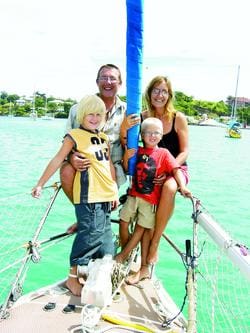To the editor: The majority of sailors out here in the ocean doing it, have never let go of their land-bound concept of Father Time and his little sister Patience. Take, for example, one of our recent passages, from Panama to the Galapagos Islands, a rhumb line voyage of 850 miles. We left on Friday the 13th (not through bloody-mindedness, but because we got our days mixed up) and sailed out of the anchorage knowing that the winds would be light. They had been light for some time with no chance of getting better. The VHF crackled to life. “Hope you’ve picked up some fuel Pagos, otherwise you’ll never get there!”
We grinned at each other and set the sails. Day one was a revelation, 150 miles in 24 hours, a record for Pagos, our 38-foot Westerly Ocean Ranger. The following days went by more slowly, hampered by a southwesterly wind, which steadfastly refused to turn to a more favorable angle. We started to tack across our rhumb line, cursing the northerly set of the Humboldt Current. Every other day we hove to for washing, making water, a tidy up and general maintenance. The kerosene cooker decided to carbon up, we wanted to change all our lights on the boat to LED to save electricity and school had to be done each morning. At 0830 each day we joined the informal net on the SSB and gave our position and weather. Each time we were asked without fail whether we had turned on the engine. Each day we replied that no we hadn’t as we had wind to sail.
On day four, a 45-foot sloop passed us heading on a course of 230°, straight to the Galapagos. They had left two days after us and steamed past us doing more than 7 knots. We hailed them on the VHF and talked to them over the sound of their trusty engine, chugging away in the background. They asked us where we were going; they thought Easter Island as we were heading south. We patiently explained that we were in fact heading to the Galapagos but were tacking across the rhumb line.
“That’s really interesting Pagos, you’re going to sail there are you?”
“Yes,” we replied, “That’s the general idea.”
“That’s very brave of you, we’d love to but we don’t have the time for that. We decided we wanted to complete the passage in six days and not pay overtime to the port captain. We never pay overtime.”
Further questioning revealed that their engine had been running since Panama and that it would not be turned off unless the wind changed to a broad reach and they could maintain 7 knots. We asked them how much fuel they carried. They replied that they had 450 gallons. “We had the boat designed for us and fuel capacity was our primary objective.”
As you can imagine we soon lost VHF contact but continued to listen to them on the SSB. They arrived as planned on a weekday and avoided paying the overtime charge of $2.00, but spent nearly $250 in fuel consumption. On day seven another yacht steamed past us. Again we hurried down to talk to them on the VHF.
“Is everything alright with you?” they asked, concerned at our hove-to status, bobbing around in a slow, deep swell.
“Fine. We are just making water, washing some clothes and ourselves.”
There was a long silence. “Are you by any chance the boat Pagos?”
“Yes, we are, Adrian, Sue, George and Oliver on board.”
“Now we understand, we’ve heard about you lot,” they said sounding very relieved. “You’re the ones sailing to the Galapagos aren’t you?”
Out of the 30 boats that left Panama for the Galapagos between the middle of February and April there were only two boats, us and Ospray of Boston, who sailed all the way.
The moral of this story is that when you finally make the jump from the stressful land life to one on the sea, trust me it is not going to be easy. Realizing you have time is one thing, but having the patience to use it is something else altogether.
— British sailor Sue Payne and her family have been voyaging aboard their 38-foot sloop Pagos for the past five years. After an extended stay at Easter Island, they are currently voyaging in the Pacific.

